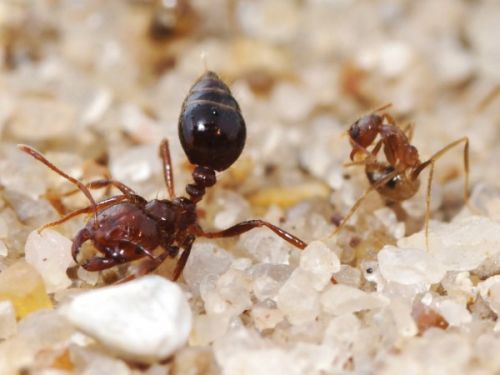We are familiar with the species of ants known as fire ants, which are famous for their painful stings. The venom in the stings causes acute pain in humans and fatal for other species of ants and insects, is known to be twice or thrice more toxic than DDT when compared on a per weight basis. Therefore, these are known to dominate the territory where they reside. However, recently a species of ants have invaded the fire ant territory and giving a tough fight to these native ants.
The southeastern U.S is facing a tiff between two species of ants. The native fire ants are being displaced by the aggressive and fast growing ants known as crazy ants and are from the southern hemisphere. The study conducted by the researchers from the University of Texas, says that crazy ant secretes a compound effective in neutralizing the venom of the fire ant. The insect’s ability to neutralize the venom of the other insect is being observed for the first time,
The study, thoroughly elaborate the process by which the crazy ants counter the effect of fire ant venom. The crazy ants when come in contact with the venom triggers the glands located at the tip of the ant’s abdomen, secretes formic acid, which is transported to the mouth to be coated on the ant’s body.
For the experiment, ecologist Ed LeBrun, at the University of Texas in Austin, placed a grasshopper in an area where the two species of ants overlapped and closely studied the competition between the two species. He noticed a unique behavior of crazy ants upon getting in contact with the venom of fire ants, These crazy ant touches their abdomen tip secreting the formic acid, with their legs and then uses these legs to spread the secretion to all over the body. And soon after the procedure they return to the battle ground. This makes them almost impossible to defeat in clashes with the fire ants over a perfect nesting place or territory with ample food stores.
LeBrun says that in the future, crazy ants will dislocate fire ants from the southeastern U.S. and will be the dominant ant species of ecology if not something unusual or different takes place.
The Process of Neutralizing The Toxin
LeBrun had already observed the crazy ants curl their abdomen beneath their body and then using their limbs to touch the tip of the abdomen known as an acidopore. The secretion from this pore is spread onto the legs first and is later smeared all over the body. In order to examine the effectiveness of the secretion, LeBrun blocked the opening of the acidopore in certain crazy ants, using nail polish. These ants and other crazy ants with unblocked acidopore, along with fire ants were kept in a vial. Almost all those crazy ants with unblocked acidopore and involved in the normal detoxification procedure, easily survived the fire ant venom. And about half of the crazy ants with blocked acidopore and unable to follow the normal detoxification method, lost the battle against the fire ants.
LeBrun also applied a mixture containing the venom of fire ants and the secretion from the glands of crazy ants, onto another Argentine ant species, that lacked the ability to fight the fire ant venom. He found that the ants treated with the mixture survived, indicating that the gland secretion was the one which protected the ants against the venom. But it is still a mystery that how formic acid actually neutralizes the venom of fire ants. He believes that the it modify the enzymes present in the venom and thus prevent the toxins from penetrating the exoskeleton of the ants.
Ancient Evolution
The unique adaptation of the crazy ants might have developed in South America in the area where the boundaries of both species of ants merge, said LeBrun. He adds that the crazy ants usually engages in this behavior only when faces fire ants rather than when approached by any other species of ants. And such confrontation often signals for evolution. And adaptation is the key for developing such specialized and unique behavior.
A Bigger Problem For The Ecology
LeBrun says that the finding of the study indicates that the fire ants are not capable enough to limit the invasion of crazy ants and this will have serious consequences on the ecology of the southern U.S.
Naturally, the crazy ants move only 200 meters per year. But with the help of humans, they can travel and spread even to further area. They have been living now throughout the southeastern U.S. and the Texas, because humans carry them to different places, in the soil of their plants, boxes that are left outside and other vehicles.
Moreover the territory in the southern U.S. where large populations of crazy ants is found, show sharp decline in the arthropods species, including spiders, centipedes, crustaceans and other insects, than in the area inhabited by fire ants. And this is going to affect the ecosystem as the birds, reptiles and other mammals will face scarcity of food.
Crazy ants do not sting but still trouble humans because they invade houses in huge numbers, unlike fire ants who preferred to stay in the garden. When inside the electric equipment, wires and boxes, they may even lead to short circuits.
Hence, fire ants are still better for the ecosystem and for the humans too. Although, they are so tiny and fragile but can have so serious impact on the ecosystem.




